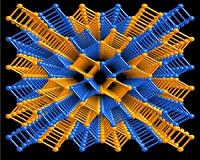 |
Washington DC (SPX) Apr 08, 2011 Although its name may make many people think of flowers, the element germanium is part of a frequently studied group of elements, called IVa, which could have applications for next-generation computer architecture as well as implications for fundamental condensed matter physics. New research conducted by Xiao-Jia Chen, Viktor Struzhkin, and Ho-Kwang (Dave) Mao from Geophysical Laboratory at Carnegie Institution for Science, along with collaborators from China, reveals details of the element's transitions under pressure. Their results show extraordinary agreement with the predictions of modern condensed matter theory. Germanium (atomic number 32) is used in fiber-optic systems, specialized camera and microscope lenses, circuitry, and solar cells. Under ambient conditions it is brittle and semiconducting. But under pressure, the element should exhibit superconductivity, meaning that there is no resistance to the flow of an electric current. The team's research, published in Physical Review Letters, discovered that under pressure of 66 GPa (about 650,000 atmospheres), germanium undergoes a structural change from one type of solid material to another that is metallic-meaning it conducts electricity. It then undergoes another structural change under pressure of 90 GPa (about 890,000 atmospheres). These findings matched theoretical predictions about the element's behavior under extreme pressure. "A series of phase transitions was observed on compression of germanium that creates structures with increased density," Chen said. "We found extraordinary agreement between theory and experiment for the structures, energies, and compressional behavior. Though some of this behavior had been noted earlier, the agreement between the new highly accurate experimental results and theory really was quite remarkable." The team's results show that superconductivity in this simple element is caused by phonons, or collective vibrations in the crystal structures that germanium assumes under pressure.
Share This Article With Planet Earth
Related Links Carnegie Institution Space Technology News - Applications and Research
 Search For Advanced Materials Aided By Discovery Of Hidden Symmetries In Nature
Search For Advanced Materials Aided By Discovery Of Hidden Symmetries In NatureUniversity Park PA (SPX) Apr 08, 2011 A new way of understanding the structure of proteins, polymers, minerals, and engineered materials will be published in the May 2011 issue of the journal Nature Materials. The discovery by two Penn State University researchers is a new type of symmetry in the structure of materials, which the researchers say greatly expands the possibilities for discovering or designing materials with desired pr ... read more |
|
| The content herein, unless otherwise known to be public domain, are Copyright 1995-2010 - SpaceDaily. AFP and UPI Wire Stories are copyright Agence France-Presse and United Press International. ESA Portal Reports are copyright European Space Agency. All NASA sourced material is public domain. Additional copyrights may apply in whole or part to other bona fide parties. Advertising does not imply endorsement,agreement or approval of any opinions, statements or information provided by SpaceDaily on any Web page published or hosted by SpaceDaily. Privacy Statement |